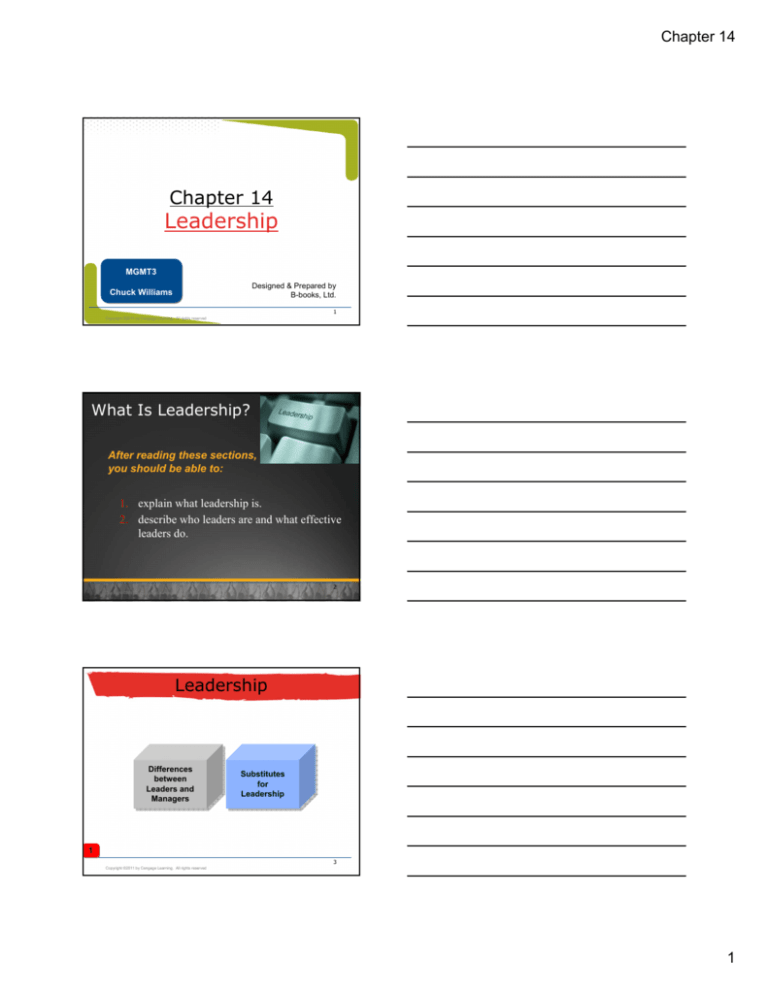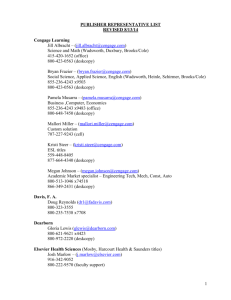
Chapter 14
Chapter 14
Leadership
MGMT3
Designed & Prepared by
B-books, Ltd.
Chuck Williams
1
Copyright ©2011 by Cengage Learning. All rights reserved
What Is Leadership?
After reading these sections,
you should be able to:
1. explain what leadership is.
2. describe who leaders are and what effective
leaders do.
2
Copyright ©2011 by Cengage Learning. All rights reserved
Leadership
Differences
Differences
between
between
Leaders
Leadersand
and
Managers
Managers
Substitutes
Substitutes
for
for
Leadership
Leadership
1
3
Copyright ©2011 by Cengage Learning. All rights reserved
1
Chapter 14
Leaders versus Managers
MANAGERS
MANAGERS
LEADERS
LEADERS
Do
Do things
things right
right
Status
Status quo
quo
Short-term
Short-term
Means
Means
Builders
Builders
Problem
Problem solving
solving
Do
Do the
the right
right thing
thing
Change
Change
Long-term
Long-term
Ends
Ends
Architects
Architects
Inspiring
Inspiring && motivating
motivating
1
4
Copyright ©2011 by Cengage Learning. All rights reserved
Leaders versus Managers
American
Americanorganizations
organizations(and
(andprobably
probablythose
thosein
inmuch
much
of
ofthe
therest
restof
ofthe
theindustrialized
industrializedworld)
world)are
areunderled
underled
and
andovermanaged.
overmanaged. They
Theydo
donot
notpay
payenough
enough
attention
attentionto
todoing
doingthe
theright
rightthing,
thing,while
whilethey
they
pay
too
much
attention
to
doing
things
pay too much attention to doing thingsright.
right.
--Warren
WarrenBennis
Bennis
1
5
Copyright ©2011 by Cengage Learning. All rights reserved
Beyond the Book
Substitutes for Leadership
• Leadership substitutes
– subordinate, task, or organizational characteristics
that make leaders redundant or unnecessary
• Leadership neutralizers
– subordinate, task, or organizational characteristics
that interfere with a leader’s actions
• Leaders don’t always matter
– Poor leadership is not the cause of every
organizational crisis
6
Copyright ©2011 by Cengage Learning. All rights reserved
2
Chapter 14
Leadership Substitutes
and Neutralizers
Characteristic
Subordinate Characteristics
• Ability, experience, training, knowledge
• Need for independence
• Professional orientation
• Indifference toward organizational rewards
Task Characteristics
• Unambiguous and routine tasks
• Performance feedback provided by the
work itself
• Intrinsically satisfying work
Organizational Characteristics
• Formalization, meaning specific plans,
goals, and areas of responsibility
• Inflexibility, meaning rigid, unbending rules
and procedures
• Highly specified staff functions
• Cohesive work groups
• Organizational rewards beyond a leader's
control
• Spatial distance between supervisors and
subordinates
Beyond the Book
People-Related
Leadership Behaviors
Task-Related
Leadership Behaviors
Neutralize
Neutralize
Substitute, Neutralize
Neutralize
Substitute, Neutralize
Neutralize
Substitute, Neutralize
Neutralize
No effect
No effect
Substitute, Neutralize
Substitute, Neutralize
Substitute, Neutralize
Neutralize
No effect
Neutralize
No effect
Neutralize
No effect
Substitute, Neutralize
Neutralize
Neutralize
Substitute, Neutralize
Neutralize
Neutralize
Neutralize
7
Copyright ©2011 by Cengage Learning. All rights reserved
Who Leaders Are and
What Leaders Do
Leadership
Leadership
Traits
Traits
Leadership
Leadership
Behavior
Behavior
2
8
Copyright ©2011 by Cengage Learning. All rights reserved
Leadership Behaviors
Initiating Structure
The degree to which a leader structures the roles
of followers by setting goals, giving directions,
setting deadlines, and assigning tasks.
Consideration
The extent to which a leader is friendly,
approachable, and supportive and shows concern
for employees.
2.2
9
Copyright ©2011 by Cengage Learning. All rights reserved
3
Chapter 14
Beyond the Book
Providing Security
Jeffrey Katzenberg, CEO of DreamWorks,
has realized that making employees feel
secure has become increasingly important,
especially in the last two years. If people
don’t feel secure, they won’t be willing to
take risks, which is crucial to success in the
film business. Katzenberg works hard to
communicate this to his employees—that
their jobs are safe, that the company is
growing (300 hires in the last year), and
that they have a strong financial position.
What kind of leadership behavior is
Katzenberg demonstrating here?
Source: J. Katzenberg, “Corner Office: The Benefit of a Boot Out the Door”, interview by A. Bryant, The New York Times, 7 November 2009.
http://www.nytimes.com/2009/11/08/business/08corner.html?pagewanted=1 (accessed 11/10/2009).
10
Copyright ©2011 by Cengage Learning. All rights reserved
Blake/Moulton Leadership Grid
High 9
1,9
Concern for People
8
Country Club
Management
Team 9,9
Management
7
6
Middle of the
5,5
Road
5,5
5
4
3
2
Low 1
Impoverished
1,1 Management
1
Low
2.2
2
3
4
AuthorityAuthorityCompliance 9,1
5
6
7
Concern for Production
8
9
High
11
Copyright ©2011 by Cengage Learning. All rights reserved
Situational Approaches to
Leadership
After reading these sections,
you should be able to:
3.
explain Fiedler’s contingency theory.
4.
describe how path-goal theory works.
5.
explain the normative decision theory.
12
Copyright ©2011 by Cengage Learning. All rights reserved
4
Chapter 14
Putting Leaders in the Right Situation:
Fiedler’s Contingency Theory
Situational
Situational
Favorableness
Favorableness
Group
Group
Performance
Performance
=
Leadership
Leadership
Style
Style
3
13
Copyright ©2011 by Cengage Learning. All rights reserved
Putting Leaders in the Right Situation:
Fiedler’s Contingency Theory
Least
Least Preferred
Preferred Coworker
Coworker
Situational
Situational Favorableness
Favorableness
Matching
Matching Leadership
Leadership Styles
Styles
to
to Situations
Situations
3
14
Copyright ©2011 by Cengage Learning. All rights reserved
Leadership Style:
Least Preferred Coworker
• Leadership style is the way a leader
generally behaves toward followers
– seen as stable and difficult to change
• Style is measured by the Least Preferred
Co-worker scale (LPC)
– relationship-oriented
– task-oriented
3.1
15
Copyright ©2011 by Cengage Learning. All rights reserved
5
Chapter 14
Leadership Style:
Least Preferred Coworker Scale
How would you rank your least-preferred coworker? He or she is:
3.1
16
Copyright ©2011 by Cengage Learning. All rights reserved
Situational Favorableness
Situational Favorableness
The degree to which a particular situation either
permits or denies a leader the chance to influence
the behavior of group members.
Three factors:
Leader-member relations
Task structure
Position power
3.2
17
Copyright ©2011 by Cengage Learning. All rights reserved
Situational Favorableness
3.2
18
Copyright ©2011 by Cengage Learning. All rights reserved
6
Chapter 14
Matching Leadership Styles to
Situations
3.3
19
Copyright ©2011 by Cengage Learning. All rights reserved
Path-Goal Theory
Path-Goal Theory
A leadership theory that states that leaders can
increase subordinate satisfaction and performance by
clarifying and clearing the paths to goals and by
increasing the number and kinds of rewards available
for goal attainment.
4
20
Copyright ©2011 by Cengage Learning. All rights reserved
How to Apply Path-Goal Theory
Clarify
Clarifypaths
paths to
to goals
goals
Clear
Clear paths
paths to
to goals
goals by
bysolving
solving problems
problems
and
and removing
removing roadblocks
roadblocks
Increase
Increase the
the number
number and
and kinds
kinds of
of rewards
rewards
available
available for
for goal
goal attainment
attainment
Do
Do things
things that
that satisfy
satisfyfollowers
followers today
todayor
or will
will
lead
lead to
to future
future rewards
rewards or
or satisfaction
satisfaction
4
Offer
Offer followers
followers something
something unique
unique and
and valuable
valuable
beyond
beyond what
what they’re
they’re experiencing
experiencing
21
Copyright ©2011 by Cengage Learning. All rights reserved
7
Chapter 14
Path-Goal Theory
Subordinate
SubordinateContingencies
Contingencies
•Perceived
•PerceivedAbility
Ability
•Locus
•LocusofofControl
Control
•Experience
•Experience
Outcomes
Outcomes
Leadership
LeadershipStyles
Styles
•Subordinate
•Subordinatesatisfaction
satisfaction
•Subordinate
•Subordinateperformance
performance
•Directive
•Directive
•Supportive
•Supportive
•Participative
•Participative
•Achievement-Oriented
•Achievement-Oriented
Environmental
EnvironmentalContingencies
Contingencies
•Task
•TaskStructure
Structure
•Formal
•FormalAuthority
AuthoritySystem
System
•Primary
•PrimaryWork
WorkGroup
Group
4
22
Copyright ©2011 by Cengage Learning. All rights reserved
Adapting Leader Behavior:
Path-Goal Theory
Leadership
Leadership
Styles
Styles
Subordinate
Subordinate
and
and
Environmental
Environmental
Contingencies
Contingencies
Outcomes
Outcomes
4
23
Copyright ©2011 by Cengage Learning. All rights reserved
Leadership Styles
• Directive
– clarifying expectations and guidelines
• Supportive
– being friendly and approachable
• Participative
– allowing input on decisions
4.1
• Achievement-Oriented
– setting challenging goals
24
Copyright ©2011 by Cengage Learning. All rights reserved
8
Chapter 14
Subordinate and
Environmental Contingencies
Subordinate
Environmental
Perceived
Perceived ability
ability
Task structure
Locus
Locus of
of control
control
Formal authority
system
Experience
Experience
Primary work group
4.2
25
Copyright ©2011 by Cengage Learning. All rights reserved
Beyond the Book
Control What You Can
Wendy Kopp, founder and CEO of Teach
for America which provides teachers for
urban and rural public schools, has found
that the most predictive trait of success in
her teachers is an internal locus of control.
As she says, there are many factors that
could be blamed for student difficulties—
kids, kids’ families, the education system—
but the successful teachers will figure out
what they can control within the given
environment and own it and use it to their
advantage.
Source: W. Kopp, “Corner Office: Charisma? To Her It’s Overrated”, interview by A. Bryant, The New York Times, 4 July 2009.
http://www.nytimes.com/2009/07/05/business/05corner.html (accessed 11/2/2009).
26
Copyright ©2011 by Cengage Learning. All rights reserved
Path Goal Theory:
When to Use Leadership Styles
Directive
DirectiveLeadership
Leadership
•• Unstructured
Unstructuredtasks
tasks
•• Inexperienced
Inexperiencedworkers
workers
•• Workers
Workerswith
withlow
lowperceived
perceivedability
ability
•• Workers
Workerswith
withexternal
externallocus
locusof
of
control
control
•• Unclear
formal
authority
system
Unclear formal authority system
4.2
Supportive
SupportiveLeadership
Leadership
•• Structured,
Structured,simple,
simple,repetitive
repetitive
tasks
tasks
•• Stressful,
frustrating
Stressful, frustratingtasks
tasks
•• When
Whenworkers
workerslack
lackconfidence
confidence
•• Clear
formal
authority
Clear formal authoritysystem
system
Participative
Achievement-Oriented
ParticipativeLeadership
Leadership
Achievement-OrientedLeadership
Leadership
•• Experienced
•• Unchallenging
Experiencedworkers
workers
Unchallengingtasks
tasks
•• Workers
Workerswith
withhigh
highperceived
perceivedability
ability
•• Workers
Workerswith
withinternal
internallocus
locusof
of
control
control
•• Workers
Workersnot
notsatisfied
satisfiedwith
withrewards
rewards
•• Complex
Complextasks
tasks
27
Copyright ©2011 by Cengage Learning. All rights reserved
9
Chapter 14
Beyond the Book
Adapting Leadership Behavior
Hersey and Blanchard’s Situational Leadership Theory
Worker
Worker
Readiness
Readiness
Leadership
Leadership
Styles
Styles
28
Copyright ©2011 by Cengage Learning. All rights reserved
Beyond the Book
Worker Readiness
• The ability and willingness to take responsibility
for directing one’s behavior at work
• Components of worker readiness:
– Job readiness
– Psychological readiness
29
Copyright ©2011 by Cengage Learning. All rights reserved
Beyond the Book
Worker Readiness
R4
R4
confident
confident
willing
willing
able
able
R3
R3
insecure
insecure
not
not willing
willing
able
able
R2
R2
confident
confident
willing
willing
not
not able
able
R1
R1
insecure
insecure
not
not able
able
not
not willing
willing
30
Copyright ©2011 by Cengage Learning. All rights reserved
10
Chapter 14
Beyond the Book
Leadership Styles
Telling
Telling
(R1)
(R1)
high
high task
task behavior
behavior
low
low relationship
relationship behavior
behavior
Selling
Selling
(R2)
(R2)
high
high task
task behavior
behavior
high
high relationship
relationship behavior
behavior
Participating
Participating
(R3)
(R3)
low
low task
task behavior
behavior
high
high relationship
relationship behavior
behavior
Delegating
Delegating
(R4)
(R4)
low
low task
task behavior
behavior
low
low relationship
relationship behavior
behavior
31
Copyright ©2011 by Cengage Learning. All rights reserved
Normative Decision Theory
Decision
Decision
Styles
Styles
Decision
Decision
Quality
Qualityand
and
Acceptance
Acceptance
5
32
Copyright ©2011 by Cengage Learning. All rights reserved
Decision Styles
Leader accepts any decision
supported by the entire group
Leader solves the problem
or makes the decision
AI
Solve
Solvethe
the
problem
problem
yourself
yourself
AII
Obtain
Obtain
information.
information.
Select
Selectaa
solution
solution
yourself.
yourself.
CI
CII
GII
Share
Shareproblem,
problem,
get
getideas
ideasfrom
from
individuals.
individuals.
Select
Selectaa
solution
solution
yourself.
yourself.
Share
Shareproblem
problem
with
withgroup,
group,
get
getideas.
ideas.
Make
Makedecision,
decision,
which
whichmay
mayor
or
may
maynot
notreflect
reflect
input.
input.
Share
Shareproblem
problem
with
withgroup.
group.
Together
Togethertry
try
to
toreach
reachaa
solution.
solution.
Leader
Leaderacts
actsas
as
facilitator.
facilitator.
5.1
33
Copyright ©2011 by Cengage Learning. All rights reserved
11
Chapter 14
Decision Quality and
Acceptance
© Jacob Hellbach/iStockphoto.com
• Using the right amount of employee participation:
– improves decision quality
– improves acceptance
• Decision tree helps leader identify optimal level of
participation
5.2
34
Copyright ©2011 by Cengage Learning. All rights reserved
Normative Theory Decision Rules
to Increase Decision Quality
Quality Rule
If the quality of the decision is important, then don't use an autocratic
decision style.
Leader Information Rule
If the quality of the decision is important, and if the leader doesn't
have enough information to make the decision on his or her own,
then don't use an autocratic decision style.
Subordinate Information Rule
If the quality of the decision is important, and if the subordinates
don't have enough information to make the decision themselves, then
don't use a group decision style.
5.2
35
Copyright ©2011 by Cengage Learning. All rights reserved
Normative Theory Decision Rules
to Increase Decision Quality
Goal Congruence Rule
If the quality of the decision is important, and subordinates' goals are
different from the organization's goals, then don't use a group decision
style.
Problem Structure Rule
If the quality of the decision is important, the leader doesn't have
enough information to make the decision on his or her own, and the
problem is unstructured, then don't use an autocratic decision style.
5.2
36
Copyright ©2011 by Cengage Learning. All rights reserved
12
Chapter 14
Normative Theory Decision Rules
to Increase Decision Acceptance
Commitment Probability Rule
If having subordinates accept and commit to the decision is
important, then don't use an autocratic decision style
Subordinate Conflict Rule
If having subordinates accept the decision is important and
critical to successful implementation, and if subordinates are
likely to disagree or end up in conflict over the decision, then
don't use an autocratic or consultative decision style
5.2
Commitment Requirement Rule
If having subordinates accept the decision is absolutely
required for successful implementation, and if subordinates
share the organization's goals, then don't use an autocratic or
consultative style
37
Copyright ©2011 by Cengage Learning. All rights reserved
Strategic Leadership
After reading this section,
you should be able to:
6. explain how visionary leadership
(i.e., charismatic or transformational
leadership) helps leaders achieve strategic
leadership.
38
Copyright ©2011 by Cengage Learning. All rights reserved
Visionary Leadership
Charismatic
Charismatic
Leadership
Leadership
Transformational
Transformational
Leadership
Leadership
6
39
Copyright ©2011 by Cengage Learning. All rights reserved
13
Chapter 14
Charismatic Leadership
• Creates an exceptionally strong relationship
between leader and follower
• Charismatic leaders:
– articulate a clear vision based on values
– model values consistent with vision
– communicate high performance expectations
– display confidence in followers’ abilities
6.1
40
Copyright ©2011 by Cengage Learning. All rights reserved
Beyond the Book
Building a Cathedral
Alan Mulally, CEO of Ford Motor Co., tells the following
story: When three bricklayers are asked what they are
doing, the first answers, “I’m making a living laying these
bricks.” The second answers, “I’m learning about the
profession of bricklaying so I can be the best bricklayer
ever.” Finally, the third answers, “I’m helping to build a
cathedral.” As a leader, Mulally believes, you need to
help people understand the broader vision behind what
they are doing. As people better understand the broader
vision, they will be more motivated and unified in working
towards it.
Source: A. Mulally, “Corner Office: Planes, Cars and Cathedrals”, interview by A. Bryant, The New York Times, 5 September 2009.
http://www.nytimes.com/2009/09/06/business/06corner.html (accessed 10/23/2009).
41
Copyright ©2011 by Cengage Learning. All rights reserved
Kinds of Charismatic Leaders
• Ethical Charismatics
–
–
–
–
–
provide developmental opportunities
are open to positive and negative feedback
recognize others’ contributions
share information
show concern for the interests of the group
• Unethical Charismatics
6.1
–
–
–
–
control and manipulate followers
do what is best for themselves
only want positive feedback
motivated by self-interest
42
Copyright ©2011 by Cengage Learning. All rights reserved
14
Chapter 14
Ethical and Unethical
Charismatic Leaders
Charismatic Leader
Behaviors
Ethical Charismatics
Exercising Power
Use power to serve others
Creating the vision
Allow followers to help develop the vision
Communicating with
followers
Engage in two-way communication
Accepting feedback
Are open to feedback
Stimulating followers
Want followers to think and to question the
status quo
Developing followers
Focus on developing followers
Living by moral
standards
Exhibit three virtues: courage, sense of
fairness, integrity
6.1
43
Copyright ©2011 by Cengage Learning. All rights reserved
Ethical and Unethical
Charismatic Leaders
Charismatic Leader
Behaviors
Unethical Charismatics
Exercising Power
Use power to dominate others
Creating the vision
Sole provider of vision
Communicating with
followers
Engage in one-way communication, not open
to input from others
Accepting feedback
Have an inflated ego, avoid candid feedback
Stimulating followers
Don’t want followers to think, prefer uncritical
acceptance of own ideas
Developing followers
Insensitive to followers’ needs
Living by moral
standards
Follow standards only if they satisfy
immediate self interests
6.1
44
Copyright ©2011 by Cengage Learning. All rights reserved
Reducing Risks of
Unethical Charismatics
1. Have a clearly written code of
conduct
2. Recruit, select, and promote
managers with high ethical standards
3. Train leaders how to value, seek, and
used diverse points of view
4. Train leaders and subordinates
regarding ethical leader behaviors
5. Reward those who exhibit ethical
behaviors
6.1
45
Copyright ©2011 by Cengage Learning. All rights reserved
15
Chapter 14
Transformational Leadership
• Generates awareness and
acceptance of group’s
purpose and mission
• Gets followers to
accomplish more than they
intended or thought
possible
6.2
46
Copyright ©2011 by Cengage Learning. All rights reserved
Components of
Transformational Leadership
1.
2.
3.
4.
Charisma or idealized influence
Inspirational motivation
Intellectual stimulation
Individualized consideration
6.2
47
Copyright ©2011 by Cengage Learning. All rights reserved
16





